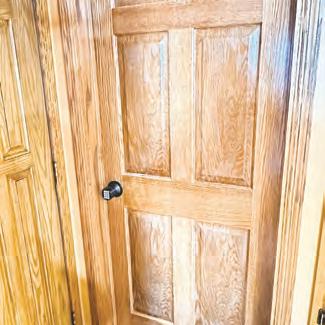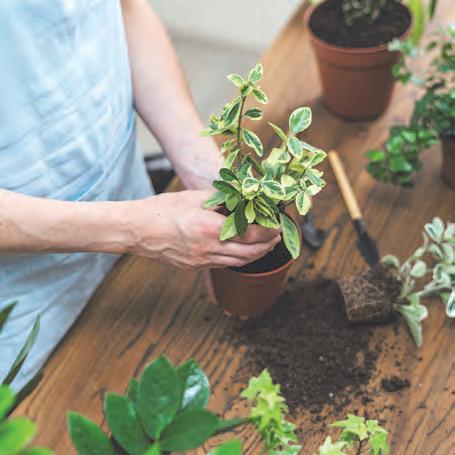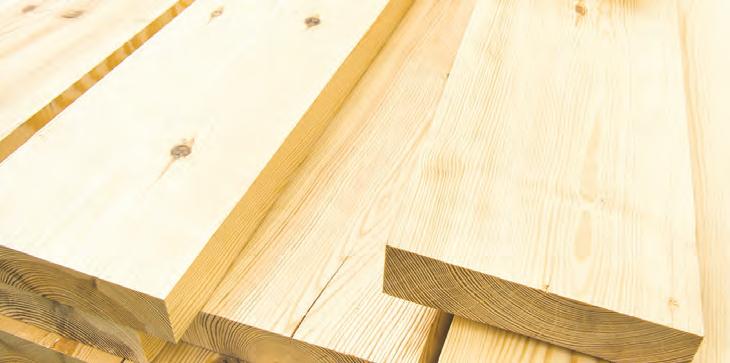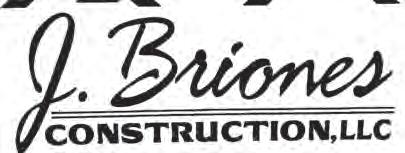home FALL
October 2023

A special supplement to The Globe

October 2023

A special supplement to The Globe
WORTHINGTON — At a time when there is a real shortage of people who work in the trades industry — contractors, plumbers, electricians — Worthington High School graduate Eric Juarez has found his niche in renovating properties and a dream of building homes.


Juarez earned his general contractor’s license in March 2022, eight years after getting his start in the local construction industry.
“I’d just freshly graduated from high school and I was looking for part-time work,” shared Juarez from a job site where he and his team installed new windows and were replacing some siding. “My brother used to work at Lampert (Lumber) as a salesperson and he kind of got me in connection with a general contractor. It went from there, and I fell in love with the job.”
His love for the job stems from taking something in need of repair and making it look new again.
“I like to see something go from nothing to something,” Juarez said. “We could take a house that looks old and deteriorated and needs work, and then we show up and do all this magic that we do and you come up with a new house.”
Juarez worked for and with several local general contractors during the past nine and a half years. About five years into his construction experience, he began dreaming of one day owning his own business. That became a reality in January, and he’s had a busy year thus far.
Diamond Vogel Paint Store| Page 3 Julie Buntjer/The Globe Eric Juarez works at a job site earlier this month where he and his team installed new windows and replaced some siding at an apartment complex in Worthington. JUAREZ: Page 11










WORTHINGTON — As autumn temperatures cool off even while fall schedules heat up, consider the power of calming down with color.
“Everyone got a little uptight during COVID,” observed Rita Hibma, manager of Worthington’s Diamond Vogel Paint Store. “People’s patience isn’t what it used to be, so maybe the idea is to get people to calm down.”
Hibma offers those thoughts by way of explaining some of the trendy paint colors — and their descriptive names — Diamond Vogel has put forward of late. What’s more, customers seem to be happily on board with the concept.


“For home exteriors, our top-seller is a dark gray called ‘Zen Retreat,’” said Hibma,
who’s been on the job at Diamond Vogel’s Oxford Street location for over 27 years.
“Charcoal grays — they go as dark as black — are very popular, but when I started, everything in exteriors was white and off-white.
“Now we’re seeing a lot of black trim, too,” she added. “Even black garage doors.”
On the inside of dwellings, light white is similarly not the most sought-after style as 2023 bends toward 2024.
In fact, three of the four Diamond Vogel 2023 feature colors tend to the dark side, maybe due to people’s tendency to seek the type of at-home comfort achieved by wrapping up in warm, soft throws or quilts.
PAINT: Page 5
ST. PAUL — As fall temperatures begin to cool, it is time to consider bringing in the houseplants you kept outside this summer.
Many houseplants thrive outdoors during Minnesota’s summers but do not perform well or may even die if exposed to chilly temperatures. Depending on the species, temperatures dipping below 45-50°F can cause damage.
Here are some things to consider before you bring your houseplants back indoors.


Aphids, mealybugs, white flies and other pests aren’t usually a problem when potted indoor plants are outside. But they can quickly turn into a major infestation during the winter if they are brought inside with the plants.
► Some experts recommend bathing or soaking plants in a bucket of water with mild dishwashing
soap before bringing them inside.
► If your plants are too big for the bucket treatment, spray them with water to remove outdoor dust and softbodied insects from the leaves.
► Next, wash the top and undersides of the leaves with water and dishwashing soap, and then rinse with water.


► It is important that the soapy water also gets into the soil as it will help to kill any pests living there, too.


► Once inside, check them with each watering for any sign of infestation and, if spotted, treat with an insecticidal soap until the problem is resolved. Wash the outside of the pots to remove dirt and any unwanted pests that might be present.
Some plants may have outgrown their pots and need something larger. Others may be too large for the indoor space and need to be pruned, separated, or even propagated to start a new plant.
Just like hardening off your new seedlings, your houseplants may undergo shock if abruptly brought from outdoor conditions to indoors. This may result in yellow leaves, wilt, dieback or even death.

Take it slow, and let them get acclimated to the indoors again a little at a time.


Most likely your plant was exposed to a lot of sun outdoors. To get it used to being back inside, temporarily put it in a very sunny window and gradually reduce its sun exposure before moving it to a less sunny location.

Geraniums, coleus, begonias and impatiens can be propagated by using cuttings to generate a new crop for next summer.
► Cuttings should be approximately 4 inches long and be taken from vigorous, healthy plants.
► Remove leaves from the bottom portions of cuttings.
► Lightweight growing mediums like vermiculite are best for developing new roots.


► Provide a consistent water supply. Use a porous clay pot, corked in the center, on a dish that you add water to.

For instance, Diamond Vogel’s Moonrose is a reddish shade (darkish with pink undertones) that Hibma has seen customers choose for accent walls alongside broader swaths of tans and off-whites.
Diamond Vogel’s promotional copy positions Moonrose as follows: “A powerful color that delivers passion and energy, along with the strength and freedom to express your true self.”
The color dubbed Ranch House, meanwhile, is a dark brown that “pairs well with earthinspired accents,” according to Diamond Vogel. Contrast colors of light beige, wood tones and off-white furniture would be appealing with Ranch House, Hibma suggests.

And then there’s Calm Interlude, a dark blue with hints of teal that Hibma says has been used for accent walls and wood cabinets.
Diamond Vogel uses the words “mysterious” and “seductive” to draw attention to Calm Interlude, saying the deep blue-green shade “inspires the senses.”
Hmmmm … maybe Calm Interlude would be ideal for a bedroom?
The lightest of the three 2023 feature colors is Fresh Start, “perfect for boosting a room’s personality,” touts Diamond Vogel. Almost
a light apple green, Fresh Start could be a good match for kitchen cabinetry with dark hardware attached.
Hibma recalls Diamond Vogel’s 2019 color of the year, Day Spa, as having similar qualities to 2023’s Calm Interlude.
“I guess people are really looking for a little more Zen in their lives,” she laughed, mentioning another lighter aqua shade christened Restful Retreat.
“Everything in marketing they want ‘calm,’” said Hibma.

Admittedly, the light blue-greens and lighter blues shaded with gray do
have noticeably calming effects, along with the ever-popular grays/ greiges/tans that Hibma says have never gone out of style since making a splash over 10 years ago.

“Those are all really popular colors,” said Hibma, tossing out names (Oak Tone and Soft Leather) fitting the greige/tan profile.
“But Place of Dust?”
Hibma questions, citing a shade Diamond Vogel terms “a flexible gray.”
“I don’t know why you’d ever name something that; I try to eliminate all my dust.”
With nearly three decades in the paint business, Hibma is quite attuned to the trend toward calming colors.

“Over 20 years ago, everything seemed to be named after food, like Creamed Corn and Pink Parfait.”

What do you know; maybe customers were hungry for change.

With buckets of experience, Hibma and her team are well stocked to serve painters, both do-it-yourselfers and professionals.

In fact, they’re better stocked now than they were a few years back, when pandemic-induced supply chain issues (and demand spurred by stir-crazy locked-down homeowners eager to fill their time and make home improvements) caused shortages of certain products.
PAINT: Page 9





 By StatePoint
By StatePoint
When the temperatures drop and the precipitation turns cold, efficiently keeping your home cozy and warm is likely a top priority.

As you make home upgrades this fall, be sure to use materials designed to withstand extreme weather events and which help manage indoor climate control. Doing so will mean greater comfort and more affordable energy bills, not only when it’s cold, but all year long.
As your first defense against all kinds of weather, your roof sustains a lot of wear and tear. Consider prioritizing durability, strength and weather resistance in a new roof by opting for metal.
The good news? You can get a classic appearance with this material, thanks to updates in roofing technology. For example, the energy-saving metal roofing offered by ProVia has the textured appearance of natural slate or shake shingles, but is constructed of highly durable 26-gauge steel, for added strength and lifetime protection from wind, rain, hail and corrosion.


Is your home drafty or chilly when the temperatures drop and the wind kicks up? The culprit may be insufficient insulation. Keep in mind that most wall insulation is placed only between the studs, and wall studs make

up to 25% of the wall surface of an average home.


You can fill in these insulation gaps with insulated vinyl siding that’s been tested and proven to increase the R-value (a measure of a material’s resistance to heat flow) of an exterior wall.
One of the most energy-efficient exterior claddings on the market, CedarMAX insulated vinyl siding is one such choice that can help reduce your energy bills. Plus, its strong, rigid foam backing offers greater impact resistance against rain, hail, sleet and snow, making a siding upgrade a good project to consider before the first winter storm.
Windows are a common point of heat transfer, and as such, they play a huge role in the comfort of your home. It’s not often that you have to purchase windows for your home, but when you do, you’ll want to ensure they deliver the best in energy efficiency and
comfort. ProVia’s vinyl windows, for example, are Energy Star-certified, to help keep your home warm in winter (and cool in summer).
You may not think about your interior decorating choices as something that could potentially improve your home’s energy efficiency, but many such updates will not only make your home look more cozy, they’ll actually help keep it warm.
Thick area rugs are a good place to start, as they provide insulation underfoot. Likewise, cellular shades or Roman shades can help stop heat transfer around windows, and wall tapestries or fabric-like wallpaper can provide a touch more insulation on walls.
To learn more about building and renovating with comfort and energy savings in mind, visit provia.com. By selecting the right products during a renovation, you can prepare your home for greater comfort and energy savings in cool weather.
Want to transform your outdoor space while saving money? There are plenty of hands-on projects you can do yourself to eliminate expensive labor costs. The following ideas can be tailored to your budget and personal preferences:

Make your backyard more fun and functional with a low-maintenance patio for entertaining and relaxing. Based on your budget and experience level, there are a variety of styles and materials to choose from, such as brick, concrete and stone. You’ll also need gravel to create a sturdy foundation.
If you’re building on an existing

lawn, clear out the grass and dirt first and dig an area deep enough, so the new surface will be even with the ground. Once you’ve prepped the ground and poured the gravel, use sand to hold the blocks in place and fill any gaps between the blocks once the layout is complete. Search online for step-by-step installation instructions and use a project calculator to determine the cost.

A built-in seating wall near a fire pit, pool or patio offers more places to lounge and adds depth to the space. There are plenty of DIY-friendly materials to build with, including interlocking concrete blocks, which won’t need to be recut and are heavy enough to stay in place without cement,
or larger, flat stones that look more natural and can be laid in various ways.

If you use concrete blocks, add capstones as top piece to give the design a finished look. Watch tutorials online before starting the project for inspiration and to ensure you complete all the necessary steps.



Fix up something old to make it new. If you have an above-ground pool or spa with a slow leak, easily repair it with the highly-rated T-Rex Waterproof Tape. The tape has a waterproof backing enhanced with R-Flex Technology for greater durability. It’s also UV-resistant, can stretch up to 700% of its original length and is strong enough to be used underwater. Locate the leak and then measure and cut a piece of tape with scissors (this tape is too tough to tear by hand). Remove the liner from the back and apply it to the crack to form a leakproof seal. Press down firmly and smooth any creases by hand.

A privacy screen is an easy project for beginner DIYers and will hide unsightly air conditioning units, garbage bins and utility boxes. You’ll
need weather-resistant wood slats, like cedar wood, fence posts, a drill, screws and paint or stain.
Use your “eyesore” to determine how tall to make the screen. Then, anchor fence posts into the ground and drill your first slat about an inch above the ground. Continue adding boards all the way up. For air conditioning units, leave space between each slat to ensure proper air circulation. Add a finish— dark for a modern style or clear for a natural look—and enjoy.
Use lighting to give your backyard a bistro-like atmosphere. Rather than using a drill to hang solar or string lights, use transparent, doublesided T-Rex Clear Mounting Tape to permanently and discreetly decorate. Whether placing the lights across wooden beams or on brick or vinyl fencing, make sure the surface is clean and dry before applying the tape. Stick one side to the surface and the other to mount the lights. The adhesive will build over time, achieving full strength after a 24-hour period.
Once you tackle these budget-friendly DIY projects, you’ll be ready to relax in your outdoor oasis.
After extreme weather events, it’s common to evaluate exterior home products and to feel a sense of urgency about replacing them if they’re not providing proper protection. One addition that homeowners should consider is a storm door, however, experts say it’s important not to rush the decision.


“Storm doors provide insulation, curb appeal, and weather protection for the entry door, but they are not one-size-fits-all,” says Brandon Morris, entry and storm door product manager at ProVia, a manufacturer that carries several brands of customizable aluminum storm doors. “Before making a purchase, first determine your needs and style preferences.”
To help homeowners make sense of their options, ProVia offers this roundup of essential factors to consider:

Construction

To reap the maximum benefits a storm door can provide, take thickness and construction into consideration. Those offered by ProVia all feature an aluminum wall thickness 20% greater
than industry standard, to provide greater protection to your entry door, along with stability and durability for long-term use. Most brands they carry also have multi-hollow construction, which translates to greater strength and security than standard storm doors.

Style
Storm doors are not always just functional. Certain manufacturers understand that they are a home element that can boost curb appeal, too. Decorative storm doors come with options like beveled glass, stained glass, and privacy glass, adding visual appeal, and a unique artistic statement where you least expect. Different colors and multiple options in hardware styles and finishes allow the storm door to blend in with your exterior design, whether
that’s traditional and understated or ultramodern and eye-catching.
The type of glass you choose can maximize energy efficiency. Low emissivity (Low-E) glass doors, for example, have a thin, invisible coating that reduces infrared and ultraviolet light coming through the door glass. In winter, Low-E glass lets radiant heat pass through, but doesn’t allow it to come back out, for a cozier interior. And in summer, it helps keep heat out. Low-E glass also features UV protection that can prevent fading of items inside your home.
Storm doors with removable glass panels and retractable screens enable airflow and crucial ventilation between
the storm and entry doors, while letting the design of the entryway shine.
Accessories can create additional functionality for your storm door. Have a furry friend who needs regular outdoor access? Consider a doggie door so they can come and go as they please. Some manufacturers offer this option in multiple sizes to fit your pet’s needs. No streetside mailbox on your property? Add a mail slot to your storm door.
Other optional features, such as a piano hinge and bottom expander, and an easy release closer, can help your storm door operate more smoothly, while ensuring it’s custom-fit to eliminate drafts.
For more storm door tips and recommendations, visit provia.com/ doors/storm-doors/.
Like many home elements, there’s a lot to consider when selecting storm doors. By weighing your style preferences and security needs, and by determining what add-ons your household can benefit from, you can make a decision you won’t regret.

“We couldn’t get direct-to-metal (water-based) products then, and now we have those plus the latex products and the solid stains,” said Hibma. “They just couldn’t get the raw materials awhile ago to make them.”
Hibma assures that Diamond Vogel is back to being fully stocked.
“I said a few months ago, ‘Wow, we finally look like a paint store again,’” she joked.
In addition to having different levels of paints, from classic to premium, Diamond Vogel has the full range of items anyone could ever need to embark on a painting project.
Paintbrushes, rollers, roller covers, paint sticks, tape, pans, drop cloths, plastic sheeting, caulk, stains, clear coats, deck cleaners, deck sealants and deck stains are all part of the local inventory, Hibma listed.
“And we also carry blinds of all kinds,” she added, noting their array of cellular, cordless, wood, cloth, roller and vertical blinds and shades.


“They’re all custom-made so they can suit any window opening and come in a variety of price points.”

Hibma chuckled when recalling how, on the hottest summer days, customer calls for blinds increased as the mercury rose.
“The summer sun was good for the
blind business,” she said. However, the Oxford Street construction phases have been less helpful, since Diamond Vogel is situated on Oxford’s south side near its intersection with Church Street. Walk-in business has been “challenging” during the construction months, Hibma admitted.
“But we service such a large area (within an hour’s radius of Worthington) that we’ve kept busy with customers from outside town,” said Hibma, who is nevertheless eager to see road construction season wrap up. Still, as construction continues, access remains possible by driving eastward on Oxford, or via the alley off Church Street, she explains.
Clients in Marshall, Jackson, Sibley, Windom, Luverne and more have benefited from the responsiveness of Hibma and her staff, plus have used their delivery service (a local option, too, as is curbside pickup).

Hibma is encouraging to those newer to do-it-yourself home improvement and is happy to offer tips to make the process easier.
“September and October can be good months to paint (exteriors) because it’s not so darn hot,” she said, adding that people need to pay attention when nightly forecasts dip below 40 degrees because of the way paint is affected at or below the freezing mark.
“But you can paint interiors anytime — and now is a good time to spruce up before Thanksgiving and Christmas.”
Hibma said she tells first-time painters who come to Diamond Vogel that they’re already on the right track simply by being there.
“I say, ‘You did the right thing because you came here to get quality paint,’” Hibma said. “That’s the No. 1 thing to make painting easier: good paint. And the second most important thing is getting quality tools,” she continued.
“We ask a lot of questions to find out what someone is painting, what room the paint will be applied in and if they plan to brush or roll it. Because if you
have the right product and the right tool, your project will be a success and you’ll tell your friends how easy it was — and then you’ll come back and do more.”
Doing more with less is, in fact, the name of the game when it comes to paint, Hibma asserts.

“Painting is probably the cheapest way to add value to your house, whether inside or outside,” she said. “A fresh coat of paint makes everything look newer, cleaner and brighter.”
Diamond Vogel Paint Store, 1238 Oxford St., Worthington, business hours Monday through Saturday. Call 507376-5727 or visit diamondvogel.com/ worthington for more information.

“That’s
Rita Hibma, manager of Worthington’s Diamond Vogel Paint StoreBy Jon Trappe University of Minnesota Extension turfgrass educator
ST. PAUL — With autumn approaching, we will begin seeing cooler daytime and evening temperatures, along with (hopefully) more predictable rainfall patterns.
The cool-season turfgrasses growing in our lawns will be recovering and trying to fill in any bare spots from summer stress as we move into their more preferred growing conditions.
At the same time, summer annual plants like crabgrass or foxtail have begun to set seed before withering away. Perennial weeds like dandelion or creeping Charlie will still be hanging around but have spent their resources flowering throughout the summer.
This is the best time of the year to encourage a healthy lawn next year through proper fertilization and weed control.


Most lawns benefit from some nitrogen from fertilizer. This nitrogen will be used by the turf plants to fill in any thin or bare spots, as well as take back some of the space filled in from summer annual weeds.

Lawns also will use this nitrogen to develop a deeper root system, preparing it for any dry periods next year.
For more information, visit: https://extension.umn.edu/lawncare/fertilizing-lawns
With the past three years of excessive heat and summer drought in a row, many lawns have suffered. Consider this a great opportunity to update any bare areas with a new and improved cultivar or species that will be better adapted for future stressful summers. Overseed with more drought-tolerant turfgrasses
like fine fescues or turf-type tall fescues.

Now is a great time to re-establish dead areas by overseeding. In some cases, you may want to rake to remove any dead or bare soils to encourage better seed-to-soil contact. But, as we are in an El Niño year, which is typically drier than normal, it may be a good idea to keep some seed for dormant seeding areas where there is poor germination and emergence this fall.
For more information, visit: https://extension. umn.edu/lawn-care/renovating-lawn-quality-andsustainability

Summer annuals like crabgrass and foxtail will be dying off shortly, so you don’t need to try and control them now. But perennial broadleaf weeds like dandelion, creeping Charlie, wild violet, Canada thistle, or yellow woodsorrel are still going to be growing and developing. Now is the best time to try and control these perennial plants through selective herbicides like 2,4-D, triclopyr or dicamba, which will not harm the turf plants.
The best weed control method in lawns is a dense and healthy turf that has few places for invasive weeds to encroach.
For more information, visit https://extension. umn.edu/lawn-care/lawn-weeds.
He teamed up with Worthington native Michael Edwards, of Heron Lake, another general contractor who operates under M.E. The Werks Construction. During the winter months they work together doing snow removal, and they’re ready to hit the ground running when construction season starts up.
“Mike, when I started, he was one of those persons that pushed me and told me, ‘Hey, there’s a future in this for you,’” Juarez shared. “Another person is Joe and Juanita Briones. They pushed me tremendously and they were on me to get licensed and get everything set up for my business.
“This has been my first year officially on my own. It is nice, and it’s been a great year,” he added.
Juarez said he’s built several decks this summer, installed new siding and windows for clients, and they’ve had a lot of shingling projects.

“Really, we show up in one area and then we’ll have two or four more people come up to us and be like, ‘Hey, we want you guys to take care of ours.’”
With the workload, Juarez and Edwards have two full-time employees, including Miguel Ramirez, who brings with him experience in concrete work for doing sidewalks, patios and driveways. They also hire other local
contractors for big jobs, including Keith Kruse Construction, who was helping out on a recent window and siding project at an apartment complex.


“We bring all these years of experience,” Juarez said of his fellow contractors. “We just like to be versatile and offer a little bit of everything.”
He said there’s no job too big or too small for them to do, and the fact that they’re bilingual helps in getting jobs from both the English and Spanishspeaking population locally.
Edwards, with 21 years of construction experience, said he and Juarez can do everything from residential to commercial and agricultural construction projects.
“We do more renovations, but we like to do new builds as well,” Edwards said. “We do everything from the ground up.”
Juarez said new home construction is something he’s building toward.
“I always tell my wife (Fabiola Andrade) we’ll have the opportunity at some point to be able to build our own home — that’s our goal,” Juarez said.
To view some of the projects Eric Juarez Construction has completed, visit his Facebook and Instagram pages.
“You can find all of our most recent projects that we’ve done,” he said.




